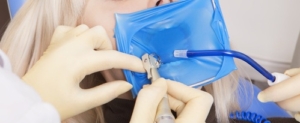A rubber dam is a sheet used to isolate a tooth from the surrounding tissues (tongue, cheeks, palate) during dental procedures. The complete rubber dam system consists of a square-shaped rubber sheet, a metal frame, and a clamp that secures the sheet to the tooth.
What are the functions of a rubber dam?

It provides a dry working field. All white (composite) fillings require the tooth to be completely dry so that the filling can bond properly.
Saliva bacteria cannot compromise the treatment of the tooth, as contamination is prevented.
The patient doesn’t have to worry about water in the mouth—whether it will go down their throat, etc. The rubber dam prevents treatment fluids from contacting the oral mucosa.
There’s no need to wonder “where to put the tongue.” This is often a big problem, especially during longer procedures when the muscles get tired and are difficult to control. The tongue is completely protected and isolated under the rubber dam.
It protects the mouth from material or metal particles that may fall during the replacement of an old filling. Nothing can enter your mouth—everything stays outside the dam.
For patients with a strong gag reflex, the rubber dam helps by shielding the sensitive areas of the soft tissues in the back of the mouth from being touched by any instruments or the dentist’s mirror.
It protects the lips and cheeks from sharp or hot instruments.
How does a patient feel with a rubber dam?
Think of the rubber dam as a barrier between your mouth and the procedure being performed “on the outside.” Nothing that happens to the tooth can harm you or make your time in the dental chair uncomfortable. The metal clamp that holds the sheet in place is anatomically designed not to cause excessive pressure or pain.
You can breathe normally through both your nose and mouth under the dam. Also, you don’t need to concentrate on keeping your mouth open—the dam helps with that.
What do our patients say?
We asked one of our patients, who encountered the rubber dam for the first time, to share their experience:
“The dentist suggested using a rubber dam during the treatment and filling placement. It was a new experience for me and made the entire process easier because I could breathe and swallow freely. I didn’t have to suppress swallowing or worry about moving my tongue, and I never felt like I was going to choke. The placement itself was quick and painless.”
Modern dentistry and rubber dam use
Today, we can’t talk about modern technology and following trends without mentioning the rubber dam. Almost all procedures and materials used today require a dry working field and the absence of bacteria. Patient comfort and safety have been elevated to a new level, so ask your dentist about the rubber dam.




